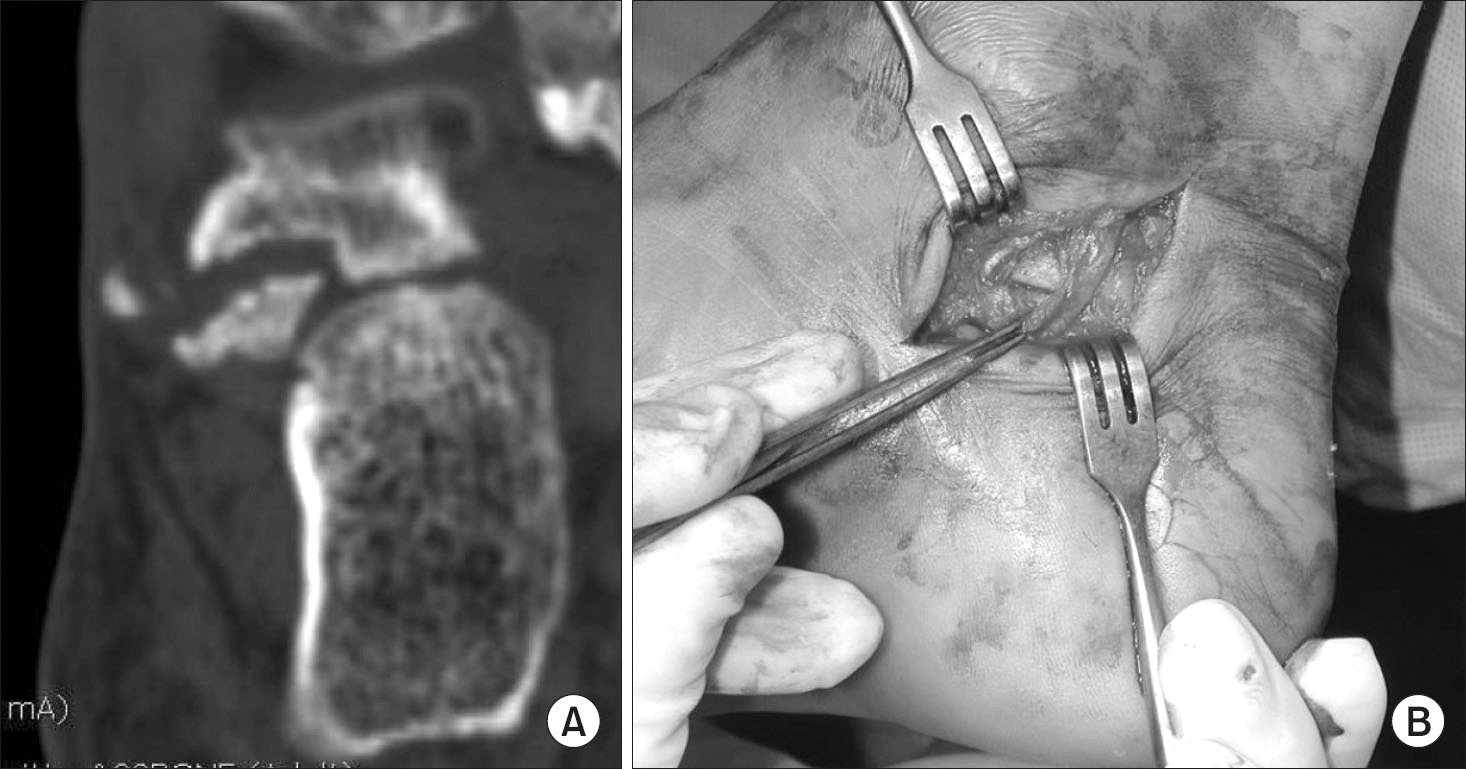Abstract
Tarsal tunnel syndrome is an entrapment neuropathy of the tibial nerve and its branches within the tarsal tunnel, which usually occurs as a result of a space-occupying lesion, trauma or foot deformity. The typical symptoms are pain and paresthesia of the foot at the dermatome of involved nerve branches, and the diagnosis can be made through careful history taking and physical examination. Treatments include conservative management and surgery. Although the reported results of surgical treatment vary, surgical decompression can yield satisfactory outcomes in cases of tarsal tunnel syndrome with a space-occupying lesion.
REFERENCES
1. Kopell HP, Thompson WA. Peripheral entrapment neuropathies of the lower extremity. N Engl J Med. 1960; 262:56–60.

4. Davis TJ, Schon LC. Branches of the tibial nerve: anatomic variations. Foot Ankle Int. 1995; 16:21–9.

5. Dellon AL, Kim J, Spaulding CM. Variations in the origin of the medial calcaneal nerve. J Am Podiatr Med Assoc. 2002; 92:97–101.

6. Heimkes B, Posel P, Stotz S, Wolf K. The proximal and distal tarsal tunnel syndromes. An anatomical study. Int Orthop. 1987; 11:193–6.
7. DiGiovanni BF, Gould JS. Tarsal tunnel syndrome and related entities. Foot Ankle Clin. 1998; 3:405–26.
9. Frey C, Kerr R. Magnetic resonance imaging and the evaluation of tarsal tunnel syndrome. Foot Ankle. 1993; 14:159–64.

10. Daniels TR, Lau JT, Hearn TC. The effects of foot position and load on tibial nerve tension. Foot Ankle Int. 1998; 19:73–8.

11. Lau JT, Daniels TR. Effects of tarsal tunnel release and stabilization procedures on tibial nerve tension in a surgically created pes planus foot. Foot Ankle Int. 1998; 19:770–7.

12. Bailie DS, Kelikian AS. Tarsal tunnel syndrome: diagnosis, surgical technique, and functional outcome. Foot Ankle Int. 1998; 19:65–72.

13. Kinoshita M, Okuda R, Morikawa J, Jotoku T, Abe M. The dorsiflexion-eversion test for diagnosis of tarsal tunnel syndrome. J Bone Joint Surg Am. 2001; 83:1835–9.

14. Jung HJ, Lee SW, Jeong YM. . The usefulness of the preoperative magnetic resonance imaging findings in the evaluation of tarsal tunnel syndrome. J Korean Soc Radiol. 2012; 66:183–92.

15. Lau JT, Daniels TR. Tarsal tunnel syndrome: a review of the literature. Foot Ankle Int. 1999; 20:201–9.

16. Ahn JH, Kim KJ, Kim HY, Choy WS, Yang DS. Surgical treatment of tarsal tunnel syndrome. J Korean Foot Ankle Soc. 2007; 11:187–91.
17. Alshami AM, Babri AS, Souvlis T, Coppieters MW. Strain in the tibial and plantar nerves with foot and ankle movements and the influence of adjacent joint positions. J Appl Biomech. 2008; 24:368–76.

18. Pomeroy G, Wilton J, Anthony S. Entrapment neuropathy about the foot and ankle: an update. J Am Acad Orthop Surg. 2015; 23:58–66.
19. Ahmad M, Tsang K, Mackenney PJ, Adedapo AO. Tarsal tunnel syndrome: a literature review. Foot Ankle Surg. 2012; 18:149–52.

20. Takakura Y, Kitada C, Sugimoto K, Tanaka Y, Tamai S. Tarsal tunnel syndrome. Causes and results of operative treatment. J Bone Joint Surg Br. 1991; 73:125–8.

21. Sung KS, Park SJ. Short-term operative outcome of tarsal tunnel syndrome due to benign space-occupying lesions. Foot Ankle Int. 2009; 30:741–5.

22. Pfeiffer WH, Cracchiolo A 3rd. Clinical results after tarsal tunnel decompression. J Bone Joint Surg Am. 1994; 76:1222–30.

23. Turan I, Rivero-Melián C, Guntner P, Rolf C. Tarsal tunnel syndrome. Outcome of surgery in longstanding cases. Clin Orthop Relat Res. 1997; 343:151–6.
Figure 1
(A) Coronal computed tomography image of a 40-year-old male shows a large not-united posteromedial talar process fracture. (B) Intraoperative photograph shows close relationship of the talar nonunion fragment and tibial nerve within the tarsal tunnel.

Figure 2
(A) Coronal magnetic resonance imaging of a 47-year-old female shows a multilocular cyst adjacent to the tibial nerve. (B) A 10-cm long curvilinear skin incision is designed over the tarsal tunnel. (C) Intraoperative photograph shows a multilocular ganglion cyst which has compressed the tibial nerve.





 PDF
PDF ePub
ePub Citation
Citation Print
Print


 XML Download
XML Download